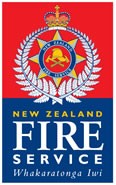New Zealand Fire Service
| Whakaratonga Iwi (Māori) | |
 |
|
| Leading integrated fire and emergency services for a safer New Zealand | |
| Operational area | |
|---|---|
| Country | New Zealand |
| Agency overview | |
| Established | 1 April 1976 |
| Annual calls | 73,464 (2013–14) |
| Employees | 1,700 career firefighters 8,300 urban volunteer firefighters |
| Staffing | 585 management and support 76 communications centre |
| Fire chief | Paul Baxter (National Commander) |
| Facilities and equipment | |
| Stations | 79 career 360 volunteer |
| Website | |
| fire |
|
The New Zealand Fire Service (NZFS, Māori: Whakaratonga Iwi, "Service to the People") is New Zealand's main firefighting body, primarily responsible for providing fire protection to urban and peri-urban areas of the country. The NZFS was established on 1 April 1976, after the Fire Service Act 1975 merged the existing local fire boards and fire brigades into a single national fire service under the new New Zealand Fire Service Commission. It is one of the very few fire brigades worldwide to have jurisdiction over an entire country.
The New Zealand Fire Service employs 1,700 career firefighters who man 79 fire stations in the major towns and cities. The remainder of the country is served by 8,300 volunteer firefighters and 360 volunteer fire brigades. In addition, it employs 585 management and support staff, and 76 communications centre staff based in three centres. In 2012/13, the Fire Service attended just over 70,900 incidents, of which 5,430 were structural fires and 16,510 were non-structural fires (e.g. vehicle, vegetation and rubbish fires).
While being a firefighting service first and foremost, the New Zealand Fire Service has also taken responsibility for several other roles, often on the basis of public expectation. These include hazardous material incidents, vehicle extrication, urban rescue, and severe weather and natural disaster response.
The NZFS is somewhat unique, internationally, in that it has jurisdiction over the entire country with no division by region or city. It is the result of the New Zealand Fire Service Act (1975) which nationalised the various District-level brigades which had developed across the country.
The New Zealand Fire Service is predominantly configured as an Urban Fire & Rescue Service. The Fire Service Act places responsibility on the NZFS for firefighting in gazetted Urban Fire Districts, totalling about 3% of New Zealand's land area but covering 85% of the country's population. The remainder of the land covered by Rural Fire Authorities (RFAs) that act under the Forest and Rural Fires Act. Fire Service brigades respond outside their Districts to deal with structure and rescue incidents, and usually undertake the initial suppression attack on wildland fires.
(Note: The New Zealand Department of Conservation is a RFA with responsibility for firefighting within recognised State areas, including National Parks, totalling about 30% of the country. The New Zealand Defence Force is responsible for all Defence Areas as defined through the Defence Act. With these two agencies included, the NZFS and territorial local authority RFAs form the bulk of the firefighting capability in New Zealand. There is some contribution from Industrial Fire Brigades (those run by commercial entities, for example forestry companies or Airport Authorities). At present, there are about 80 RFAs, but the number is being reduced through the formation of enlarged Rural Fire Districts.)
...
Wikipedia
